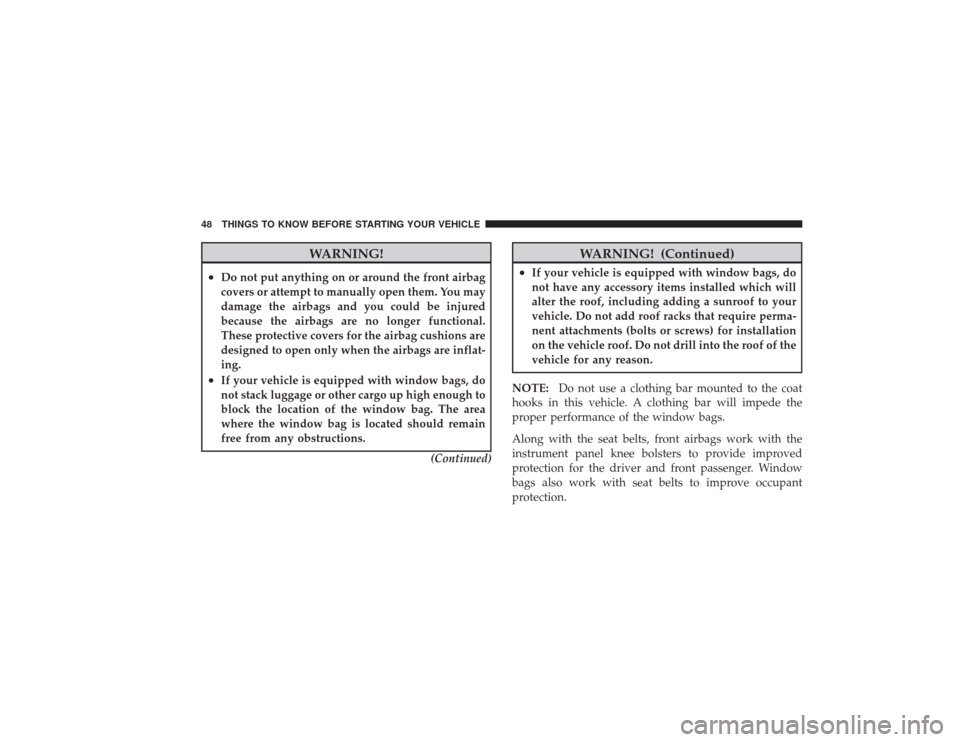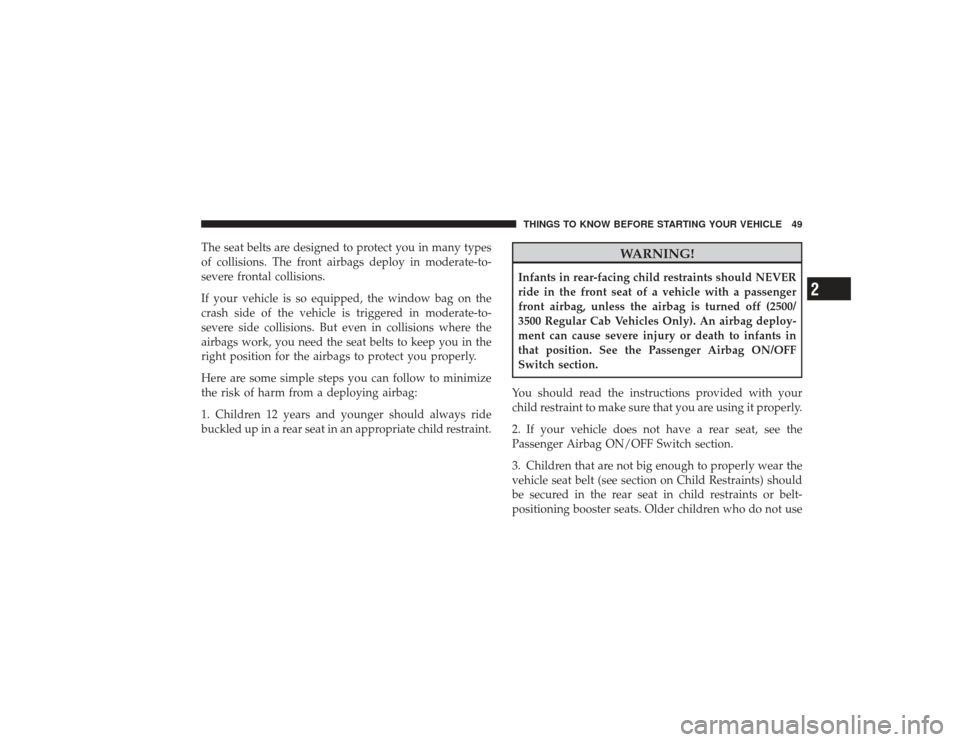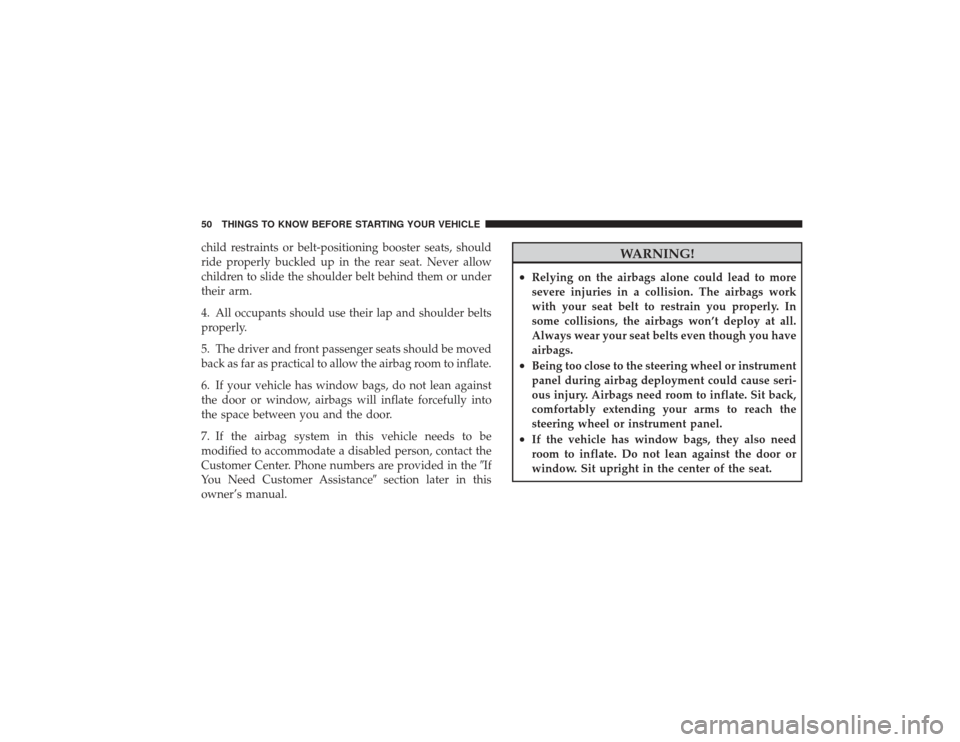Page 49 of 532

Driver And Right Front Passenger Supplemental
Restraint System (SRS) — AirbagsThis vehicle has airbags for both the driver and right
front passenger as a supplement to the seat belt restraint
systems. The driver’s front airbag is mounted in thesteering wheel. The passenger front airbag is mounted in
the instrument panel, above the glove compartment. The
words SRS/AIRBAG are embossed on the airbag covers.
NOTE:
The front airbags are certified to the Federal
regulations that allow less forceful deployment.
The front airbags have a multistage inflator design. This
may allow the airbag to have different rates of inflation
that are based on collision severity and occupant size.
This vehicle may also be equipped with window bags to
protect the driver, front, and rear passengers sitting next
to a window. If the vehicle is equipped with window
bags, they are located above the side windows. Their
covers are also labeled SRS AIRBAG.
NOTE: Airbag covers may not be obvious in the interior
trim; but they will open to allow airbag deployment.1 — Driver and Passenger Airbags
2 — Knee Bolsters THINGS TO KNOW BEFORE STARTING YOUR VEHICLE 47
2
Page 50 of 532

WARNING!
•
Do not put anything on or around the front airbag
covers or attempt to manually open them. You may
damage the airbags and you could be injured
because the airbags are no longer functional.
These protective covers for the airbag cushions are
designed to open only when the airbags are inflat-
ing.
•
If your vehicle is equipped with window bags, do
not stack luggage or other cargo up high enough to
block the location of the window bag. The area
where the window bag is located should remain
free from any obstructions.(Continued)
WARNING! (Continued)
•
If your vehicle is equipped with window bags, do
not have any accessory items installed which will
alter the roof, including adding a sunroof to your
vehicle. Do not add roof racks that require perma-
nent attachments (bolts or screws) for installation
on the vehicle roof. Do not drill into the roof of the
vehicle for any reason.
NOTE: Do not use a clothing bar mounted to the coat
hooks in this vehicle. A clothing bar will impede the
proper performance of the window bags.
Along with the seat belts, front airbags work with the
instrument panel knee bolsters to provide improved
protection for the driver and front passenger. Window
bags also work with seat belts to improve occupant
protection.
48 THINGS TO KNOW BEFORE STARTING YOUR VEHICLE
Page 51 of 532

The seat belts are designed to protect you in many types
of collisions. The front airbags deploy in moderate-to-
severe frontal collisions.
If your vehicle is so equipped, the window bag on the
crash side of the vehicle is triggered in moderate-to-
severe side collisions. But even in collisions where the
airbags work, you need the seat belts to keep you in the
right position for the airbags to protect you properly.
Here are some simple steps you can follow to minimize
the risk of harm from a deploying airbag:
1. Children 12 years and younger should always ride
buckled up in a rear seat in an appropriate child restraint.
WARNING!
Infants in rear-facing child restraints should NEVER
ride in the front seat of a vehicle with a passenger
front airbag, unless the airbag is turned off (2500/
3500 Regular Cab Vehicles Only). An airbag deploy-
ment can cause severe injury or death to infants in
that position. See the Passenger Airbag ON/OFF
Switch section.
You should read the instructions provided with your
child restraint to make sure that you are using it properly.
2. If your vehicle does not have a rear seat, see the
Passenger Airbag ON/OFF Switch section.
3. Children that are not big enough to properly wear the
vehicle seat belt (see section on Child Restraints) should
be secured in the rear seat in child restraints or belt-
positioning booster seats. Older children who do not useTHINGS TO KNOW BEFORE STARTING YOUR VEHICLE 49
2
Page 52 of 532

child restraints or belt-positioning booster seats, should
ride properly buckled up in the rear seat. Never allow
children to slide the shoulder belt behind them or under
their arm.
4. All occupants should use their lap and shoulder belts
properly.
5. The driver and front passenger seats should be moved
back as far as practical to allow the airbag room to inflate.
6. If your vehicle has window bags, do not lean against
the door or window, airbags will inflate forcefully into
the space between you and the door.
7. If the airbag system in this vehicle needs to be
modified to accommodate a disabled person, contact the
Customer Center. Phone numbers are provided in the�If
You Need Customer Assistance� section later in this
owner’s manual.
WARNING!
•
Relying on the airbags alone could lead to more
severe injuries in a collision. The airbags work
with your seat belt to restrain you properly. In
some collisions, the airbags won’t deploy at all.
Always wear your seat belts even though you have
airbags.
•
Being too close to the steering wheel or instrument
panel during airbag deployment could cause seri-
ous injury. Airbags need room to inflate. Sit back,
comfortably extending your arms to reach the
steering wheel or instrument panel.
•
If the vehicle has window bags, they also need
room to inflate. Do not lean against the door or
window. Sit upright in the center of the seat.
50 THINGS TO KNOW BEFORE STARTING YOUR VEHICLE
Page 53 of 532

Airbag System ComponentsThe airbag system consists of the following:•
Occupant Restraint Controller (ORC)
•
Side Remote Acceleration Sensors (if equipped)
•
Airbag Warning Light
•
Driver Airbag
•
Passenger Airbag
•
Window Bags above Side Windows (if equipped)
•
Steering Wheel and Column
•
Instrument Panel
•
Interconnecting Wiring
•
Knee Impact Bolsters
•
Front Acceleration Sensors (1500 Vehicles Only)
•
Driver and Front Passenger Seat Belt Pretensioners (if
equipped)
•
Driver Seat Track Position Sensor (if equipped)
•
Passenger Side Frontal Airbag ON/OFF Switch (2500/
3500 Regular Cab Vehicles Only)
•
Passenger Airbag Disable (PAD) Indicator Light
(2500/3500 Regular Cab Vehicles Only)
How the Airbag System Works
•
TheOccupant Restraint Controller (ORC) determines
if a frontal collision is severe enough to require the
airbags to inflate. The front airbag inflators are de-
signed to provide different rates of airbag inflation
from information provided by the ORC. The ORC will
not detect rollover or rear collisions.
The ORC also monitors the readiness of the electronic
parts of the system whenever the ignition switch is inTHINGS TO KNOW BEFORE STARTING YOUR VEHICLE 51
2
Page 56 of 532

the window bags to inflate, it signals the inflators on
the crash side of the vehicle. A quantity of non-toxic
gas is generated to inflate the window bag. The
inflating window bag pushes the outside edge of the
headliner out of the way and covers the window. The
airbag inflates in about 30 milliseconds (about one
quarter of the time it takes to blink your eyes) with
enough force to injure you if you are not belted and
seated properly, or if items are positioned in the area
where the window bag inflates. This especially applies
to children. The window bag is only about 3-1/2 in
(9 cm) thick when it is inflated.
NOTE: At no time should any supplemental restraint
system (SRS) component or SRS-related component or
fastener be modified or replaced with any part except
those which are approved by Chrysler LLC/Mopar�.
•
The Knee Impact Bolsters help protect the knees of
the driver and the front passenger, and positions them
for the best interaction with the front airbag.
Passenger Airbag On/Off Switch – (2500/3500
Regular Cab Vehicles Only)
Passenger Airbag On/Off Switch
54 THINGS TO KNOW BEFORE STARTING YOUR VEHICLE
Page 57 of 532

The passenger front airbag is to be turned off only if the
passenger:•
is an infant (less than one year old) who must ride in
the front seat because there is no rear seat, because the
rear seat is too small for a rear-facing infant restraint or
because the infant has a medical condition which
makes it necessary for the driver to be able to see the
infant;
•
is a child, age 1 to 12 who must ride in the front seat
because there is no rear seat, because there is no rear
seat position available, or because the child has a
medical condition which makes it necessary for the
driver to be able to see the child;
•
has a medical condition which makes passenger airbag
inflation (deployment) a greater risk for the passenger
than the risk of hitting the dashboard (instrument
panel) or windshield in a crash.
WARNING!
Whenever an airbag is turned off, even a lap/
shoulder belted passenger may hit their head, neck,
or chest on the dashboard (instrument panel) or
windshield in a crash. This may result in serious
injury or death.
To Shut Off the Passenger Airbag (2500/3500 Regular
Cab Vehicles Only)
Place the ignition key in the Passenger Airbag ON/OFF
Switch, push the key in and turn clockwise, and remove
the key from the switch. This will shut off the passenger
side airbag. The OFF light near the switch will illuminate
when the ignition switch is turned to the ON position.THINGS TO KNOW BEFORE STARTING YOUR VEHICLE 55
2
Page 59 of 532

irritation continues, see your doctor. If these particles
settle on your clothing, follow the garment manufac-
turer’s instructions for cleaning.
•
It is not advisable to drive your vehicle after the
airbags have deployed. If you are involved in another
collision, the airbags will not be in place to protect you.
WARNING!
Deployed airbags and seat belt pretensioners (if
equipped) cannot protect you in another collision.
Have the airbags, seat belt pretensioners, and the
front passenger seat belt retractor assembly, replaced
by an authorized dealer as soon as possible.
Maintaining Your Airbag System
WARNING!
•
Modifications to any part of the airbag system
could cause it to fail when you need it. You could
be injured if the airbag system is not there to
protect you. Do not modify the components or
wiring, including adding any kind of badges or
stickers to the steering wheel hub trim cover or the
upper right side of the instrument panel. Do not
modify the front bumper, vehicle body structure,
or add aftermarket side steps or running boards.
•
You need proper knee impact protection in a
collision. Do not mount or locate any aftermarket
equipment on or behind the knee bolsters.
•
It is dangerous to try to repair any part of the
airbag system yourself. Be sure to tell anyone who
works on your vehicle that it has an airbag system.THINGS TO KNOW BEFORE STARTING YOUR VEHICLE 57
2